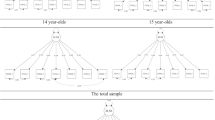Abstract
The paper describes the development of the Portuguese version of the Students’ Life Satisfaction Scale and the examination of its psychometric properties. A sample of 367 Portuguese students completed the Students’ Life Satisfaction Scale (SLSS; Huebner in Sch Psychol Int 12:231–240, 1991a), Children’s Hope Scale (CHS; Synder in J Pediatr Psychol 22:399–421, 1997), Global Self-Worth Sub-scale (Harter, S. (1985). Manual for the self-perception profile for children. Denver: University of Denver) and Mental Health Inventory-5 (MHI-5; Berwick et al. in Medical Care 29:169–176, 1991). The first step includes translation, back-translation, inspection for lexical equivalence and content validity, and cognitive debriefing. Then we considered reliability, factor structure, and criterion-related validity. The validation process of the Portuguese SLSS version shows psychometric properties similar to the English language SLSS, suggesting that it measures the same construct in the same way. Implications of these findings are discussed.
Similar content being viewed by others
References
Adelman, H. S., Taylor, L., & Nelson, P. (1989). Minors’ dissatisfaction with their life circumstances. Child Psychiatry and Human Development, 20, 135–147.
Alves-Martins, M., Peixoto, F., Mata, L., & Monteiro, V. (1995). Escala de auto-conceito para criancas e pre-adolescentes. (Self-perception profile for children of Susan Harter). In L. S. Almeida, M. R. Simões, & M. M. Gonçalves (Eds.), Provas Psicológicas em Portugal (pp. 79–89). Braga: APPORT.
American Psychological Association. (1993). Guidelines for providers of psychological services to ethnic, linguistic, and culturally diverse populations. American Psychologist, 48, 45–48.
Andrews, F. M., & Withey, S. B. (1976). Social indicators of well-being: American’s perceptions of life quality. New York: Plenum.
Berwick, D. M., Murphy, J. M., Goldman, P. A., Ware, J. E., Barsky, A. J., & Weinstein, M. C. (1991). Performance of a five-item mental health screening test. Medical Care, 29, 169–176.
Casas, F., Alsinet, F., Rossich, M., Huebner, E. S., & Laughlin, J. (2001). Cross-cultural investigation of the Multidimensional Students’ Life Satisfaction Scale with Spanish adolescents. In F. Casas & C. Saurina (Eds.), Proceedings of the III Conference of International Quality of Life Studies (pp. 359–366). Girona, Spain: University of Girona Press.
Chang, E. C. (2003). A critical appraisal and extension of hope theory in middle-aged men and women: Is it important to distinguish agency and pathway components? Journal of Social and Clinical Psychology, 22, 121–143.
Cummins, R. A. (1997). Comprehensive Quality of Life Scale—school version (Grades 7–12) (5th edn.). Melbourne, Australia: School of Psychology, Dcakin University.
Dew, T., & Huebner, E. S. (1994). Adolescents’ perceived quality of life: An exploratory investigation. Journal of School Psychology, 33, 185–199.
Diener, E. (2000). Subjective well-being: The science of happiness and a proposal for a national index. American Psychologist, 55, 34–43.
Diener, E., & Diener, C. (1996). Most people are happy. Psychologie Scolaire, 7, 181–185.
Diener, E., Emmons, R. A., Larsen, R. J., & Griffin, S. (1985). The Satisfaction with Life Scale. Journal of Personality Assessment, 49, 71–76.
Diener, E., Suh, E. M., Lucas, R. E., & Smith, H. L. (1999). Subjective well-being: Three decades of progress. Psychological Bulletin, 125, 276–302.
Fogle, L. M., Huebner, E. S., & Laughlin, J. E. (2002). The relationship between temperament and life satisfaction in adolescence: Cognitive and behavioural mediation models. J Happiness Studies, 3, 373–392.
Frisch, M. B. (2000). Improving mental and physical health care through quality of life therapy and assessment. In E. Diener & D. R. Rahtz (Eds.), Advances in quality of life theory and research (pp. 207–241). Great Britain: Kluwer Academic Publishers.
Gilman, R., Dooley, J., & Florell, D. (2006). Relative levels of hope and their relationship with academic and psychological indicators among adolescents. Journal of Social and Clinical Psychology, 23, 166–178.
Gilman, R., & Huebner, E. S. (1997). Children’s reports of their life satisfaction. School Psychology International, 18, 229–243.
Greenspoon, P. J., & Saklofske, D. H. (1997). Validity and reliability of the Multidimensional Students’ Life Satisfaction Scale with Canadian children. Journal of Psychoeducational Assessment, 15, 138–155.
Harter, S. (1985). Manual for the self-perception profile for children. Denver: University of Denver.
Huebner, E. S. (1991a). Initial development of the Student’ Life Satisfaction Scale. School Psychology International, 12, 231–240.
Huebner, E. S. (1991b). Correlates of life satisfaction in children. School Psychology Quarterly, 6, 103–111.
Huebner, E. S. (1994). Preliminary development and validation of a multidimensional life satisfaction scale for children. Psychological Assessment, 6, 149–158.
Huebner, E. S. (1995). The Students’ Life Satisfaction Scale: An assessment of psychometric properties with black and white elementary school students. Social Indicators Research, 34, 315–323.
Huebner, E. S. (2004). Research on assessment of life satisfaction of children and adolescents. Social Indicators Research, 66, 3–33.
Huebner, E. S., & Alderman, G. L. (1993). Convergent and discriminant validation of a children’s life satisfaction scale: It’s relationship to self and teacher-reported psychological problems and school functioning. Social Indicators Research, 30, 71–82.
Huebner, E. S., Brantley, A., Nagle, R., & Valois, R. F. (2002). Correspondence between parent and adolescent ratings of life satisfaction for adolescents with and without mild mental disabilities. Journal of Psychoeducational Assessment, 20, 20–29.
Huebner, E. S., & Dew, T. (1993). An evaluation of racial bias in a life satisfaction scale. Psychology in the Schools, 30, 305–309.
Huebner, E. S., Drane, W., & Valois, R. F. (2000a). Levels and demographic correlates of adolescent life satisfaction reports. School Psychology International, 21, 281–292.
Huebner, E. S., Funk, B. A., & Gilman, R. (2000b). Cross-sectional and longitudinal psychosocial correlates of adolescent life satisfaction reports. Canadian Journal of School Psychology, 16, 53–64.
Huebner, E. S., Suldo, S. M., Smith, L. C., & McKnight, C. G. (2004). Life satisfaction in children and youth: Empirical foundations and implications for school psychologists. School Psychology International, 12, 231–240.
Huebner, E. S., Suldo, S. M., & Valois, R. F. (2003). Psychometric properties of two brief measures of children’s life satisfaction: The Students’ Life Satisfaction Scale and the Brief Multidimensional Students’ Life Satisfaction Scale. Paper presented at the Indicators of Positive Development Conference, Washington, DC.
Leung, J. P., & Zhang, L. (2000). Modelling life satisfaction of Chinese adolescents in Hong Kong. International Journal of Behavioural Development, 24, 99–104.
Marques, S. C., & Ribeiro, J. P. (2006a). Contribution to the psychometric and structural study of the brief life satisfaction scale for students: A preliminary study. In C. Machado, L. Almeida, A. Guisande, M. Gonçalves, & V. Ramalho (Eds.), Proceedings of the XI International Conference of Psychological Evaluation: Shapes and Contexts (pp. 537–543). Braga, Portugal: Psiquilibrios Edittions.
Marques, S. C., & Ribeiro, J. P. (2006b). Contribution to the psychometric and structural study of the children’s hope scale: A preliminary study. In C. Machado, L. Almeida, A. Guisande, M. Gonçalves, & V. Ramalho (Eds.), Proceedings of the XI International Conference of Psychological Evaluation: Shapes and Contexts. (pp. 301–307). Braga, Portugal: Psiquilibrios Edittions.
Marques, S. C., Pais-Ribeiro, J. L., & Lopez, S. J. (2007). Validation of a Portuguese Version of the Children Hope Scale. Submitted
McKnight, C. G., Huebner, E. S., & Suldo, S. M. (2002). Relationships among stressful life events, temperament, problem behaviour, and global life satisfaction in adolescents. Psychology in the Schools, 39, 677–687.
Neto, F. (1993). Satisfaction with life scale: Psychometric properties in an adolescent sample. Journal of Youth and Adolescence, 22, 125–134.
Neto, F. (2001). Satisfaction with life among adolescents from immigrant families in Portugal. Journal of Youth and Adolescence, 30, 53–67.
Pais-Ribeiro, J. L. (2001). Mental Health Inventory: A study of adaptation to Portuguese population. Psicologia, Saúde & Doenças, 2, 77–99.
Park, N. (2000). Life satisfaction among children and adolescents: Cross-cultural and cross-developmental comparisons. Doctoral dissertation, University of South Carolina.
Pavot, W., Diener, E., Colvin, C., & Sandvik, E. (1991). Further validation of the Satisfaction with Life Scale: Evidence for the Cross-method convergence of well-being measures. Journal of Personality Assessment, 57, 149–161.
Piers, E. (1984). Piers–Harris Children’s Self-Concept Scale. Los Angeles, CA: Western Psychological Services.
Raphael, D., Rukholm, E., Brown, I., Hill-Bailey, P., & Donato, E. (1996). The Quality of Life Profile—adolescent version: Background, description, and initial validation. Journal of Adolescent Health, 19, 366–375.
Seligson, J. L., Huebner, E. S., & Valois, R. F. (2003). Preliminary validation of the Brief Multidimensional Student’s Life Satisfaction Scale (BMSLSS). Social Indicators Research, 61, 121–145.
Snyder, C. R., Hoza, B., Pelham, W. E., Rapoff, M., Ware, L., Danovsky, M., et al. (1997). The development and validation of the Children’s Hope Scale. Journal of Pediatric Psychology, 22, 399–421.
Snyder, C. R., Lopez, S. J., Shorey, H. S., Rand, K. L., & Feldman, D. B. (2003). Hope theory, measurements, and applications to school psychology. School Psychology Quarterly, 18, 122–139.
Stewart, A. L., Hays, R. D., & Ware, J. E. (1988). The MOS Short-Form General Health Survey: Reliability and validity in a patient population. Medical Care, 26, 724–735.
Suldo, S. M., & Huebner, E. S. (2004a). Does life satisfaction moderate the effects of stressful life events on psychopathological behaviour in adolescence? School Psychology Quarterly, 19, 93–105.
Suldo, S. M., & Huebner, E. S. (2004b). The role of life satisfaction in the relationship between authoritative parenting dimension and adolescent problem behavior. Social Indicators Research, 66, 165–195.
Terry, T., & Huebner, E. S. (1995). The relationship between self-concept and life satisfaction in children. Social Indicators Research, 35, 39–52.
Valle, M. F., Huebner, E. S., & Suldo, S. M. (2004). Further evaluation of the Children’s Hope Scale. Journal of Psychoeducational Assessment, 22, 320–337.
Valois, R. E., Zullig, K. J., Huebner, E. S., & Drane, J. W. (2001). Relationship between life satisfaction and violent behaviours among adolescents. American Journal of Health Behavior, 25, 353–366.
Veit, C. T., & Ware, J. E., Jr. (1983). The structure of psychological distress and well-being in general populations. Journal of Consulting and Clinical Psychology, 51, 730–742.
Ware, J. E., Jr, Gandek, B., & IQOLA project group (1994). The SF-36 health survey: Development and use in mental health research and the IQOLA project. International Journal of Mental Health, 23, 49–73.
Ware, J. E., Jr., & Sherbourne, C. D. (1992). The MOS 36-itemshort-form health survey (SF-36): I. Conceptual framework and item selection. Medical Care, 30, 473–481.
Ware, J. E., Jr., Snow, K., Kosinski, M., & Gandek, B. (1993). SF-36 Health Survey: Manual and interpretation guide. Boston, MA: Health Institute.
Windle, M., & Lerner, R. M. (1986). Reassessing the dimensions of temperamental individuality across the life span: The Revised Dimensions of Temperament Survey (DOTS-R). Journal of Adolescent Research, 1, 213–220.
Zullig, K. J., Valois, R. F., Huebner, E. S., Oeltmann, J. E., & Drane, W. J. (2001). Relationship between perceived life satisfaction and adolescent substance abuse. Journal of Adolescent Health, 29, 279–288.
Acknowledgments
This paper was supported by a FCT grant SFRH/BD/28423/2006.
Author information
Authors and Affiliations
Corresponding author
Appendix
Appendix
Students’ Life Satisfaction Scale (SLSS)
Escala de Satisfação com a Vida (ESCV)
Gostaríamos de saber que pensamentos tens tido acerca da tua vida durante as últimas semanas. Pensa acerca da forma como passas cada dia e noite e de como tem sido a tua vida durante a maior parte deste tempo. As sete questões abaixo pedem-te para indicares a satisfação com a tua vida. Circula as palavras a seguir a cada frase que indicam o grau em que concordas ou discordas com cada frase. Por exemplo, se concordas totalmente com a frase “a vida é boa”, colocas um círculo em volta dessas palavras.
Example:

O importante é saber o que realmente pensas, por isso, responde por favor às questões tendo em conta o modo como realmente pensas e não o modo como deverias pensar. Isto não é um teste. Não existem respostas certas ou erradas.

Rights and permissions
About this article
Cite this article
Marques, S.C., Pais-Ribeiro, J.L. & Lopez, S.J. Validation of a Portuguese Version of the Students’ Life Satisfaction Scale. Applied Research Quality Life 2, 83–94 (2007). https://doi.org/10.1007/s11482-007-9031-5
Received:
Accepted:
Published:
Issue Date:
DOI: https://doi.org/10.1007/s11482-007-9031-5




